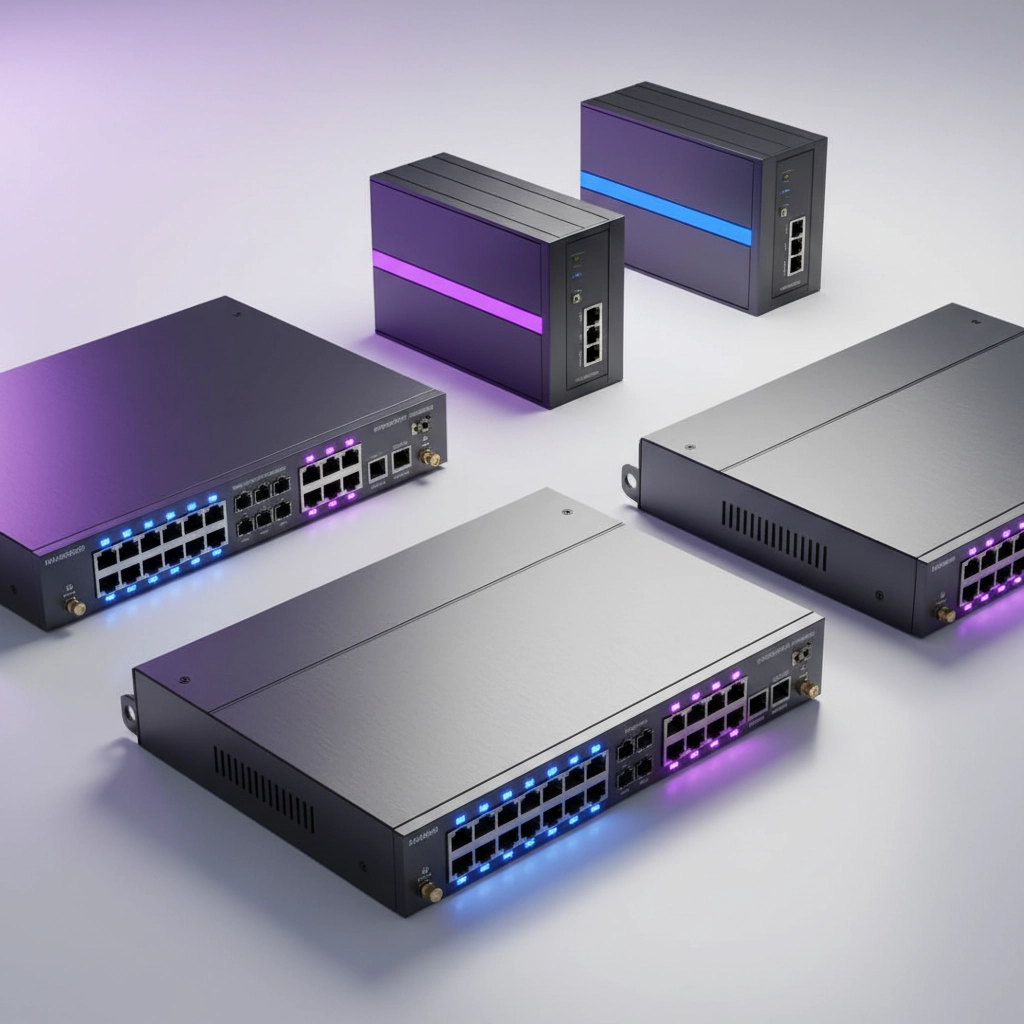Innovative AV and Managed IT Solutions
Transform your business with technology
The Ultimate Guide to AV-Over-IP Migration
The audiovisual industry is experiencing its most significant transformation since the shift from analog to digital. Traditional baseband infrastructure is rapidly giving way to IP-based solutions that offer unprecedented flexibility, scalability, and cost-effectiveness.
If you're considering migrating your organization's AV systems to an IP-based architecture, you're not alone. We've other businesses navigate this transition successfully, and we understand both the tremendous opportunities and potential pitfalls involved.
This comprehensive guide walks you through everything you need to know about AV-over-IP migration, from initial planning through successful implementation.
What Is AV-over-IP and Why Should You Care?
AV-over-IP stands for "Audio-Visual over Internet Protocol" – a technology that transmits audio and video signals across your existing network infrastructure instead of traditional dedicated cables and matrix switchers.
Think of it this way: instead of running separate cables for every video source to every display, you leverage your existing IT network to route signals anywhere in your organization. This approach transforms how we think about audiovisual distribution entirely.
The benefits are compelling. You gain the flexibility to route any source to any display without rewiring. You can scale your system easily as your needs grow. Most importantly, you eliminate the expensive proprietary hardware that has traditionally locked organizations into costly upgrade cycles.

### The Business Case for Migration
We consistently see organizations achieve significant returns on their AV-over-IP investments. Here's why the migration makes financial and operational sense:
Cost Reduction: Traditional matrix switchers and SDI routers can cost tens of thousands of dollars. AV-over-IP leverages your existing network infrastructure, dramatically reducing hardware costs.
Future-Proofing: IP-based systems integrate seamlessly with cloud platforms, automation tools, and emerging technologies. You're building infrastructure that will serve your organization for decades.
Operational Efficiency: Remote monitoring and control capabilities mean your team can manage systems from anywhere. This reduces on-site service calls and enables proactive maintenance.
Scalability: Adding new sources and displays becomes as simple as connecting to your network. No more complex rewiring projects or expensive hardware upgrades.
### Common Challenges We Help You Navigate
While AV-over-IP offers tremendous benefits, successful migration requires addressing several technical challenges. We've identified the most common issues and developed proven strategies to overcome them.
Latency Management
Latency can derail live events and interactive applications if not properly managed. We work with you to implement standards like SMPTE ST 2110 and optimize hardware selection using FPGA-based transceivers.
The key is defining acceptable latency levels for your specific applications during the planning phase. Different use cases have different requirements, and we help you understand these trade-offs.
Bandwidth Planning
Bandwidth requirements vary dramatically based on your video compression strategy. Compressed streams typically require around 1 Gbps, while uncompressed or lightly compressed streams can demand up to 10 Gbps.
We conduct thorough bandwidth assessments during our infrastructure evaluation process. This ensures your network can handle current needs while providing headroom for future growth.

Security Considerations
IP-based systems introduce cybersecurity concerns that didn't exist with isolated baseband infrastructure. We implement comprehensive security measures including VLANs, encryption, and access controls to protect your AV streams.
Our approach includes building secure network stacks and planning redundancy strategies to protect against both cyber threats and network failures.
Essential Components for Success
A successful AV-over-IP deployment requires several key components working together seamlessly. We help you select and configure each element for optimal performance.
Encoders and Decoders: These devices convert signals between traditional AV formats and IP data streams. We ensure encoder/decoder pairs are properly matched and support your chosen IP standard.
Managed Network Switches: Unlike basic unmanaged switches, managed switches provide the intelligence needed for professional AV distribution. They must support multicast and IGMP snooping for efficient signal routing.
Control Systems: Modern AV-over-IP systems require sophisticated control software to manage signal routing, configuration, and system-wide operations. We integrate these systems with your existing infrastructure for seamless operation.
Quality Cabling: Whether you're using Cat6a, Cat7, or fiber optic cables, the physical infrastructure remains critical. We help you assess your current cabling and plan any necessary upgrades.
### Our Proven Migration Process
We've refined our migration methodology through dozens of successful deployments. Our structured approach minimizes risk while ensuring optimal results.
Phase 1: Infrastructure Assessment
We begin by thoroughly evaluating your current baseband infrastructure and network capabilities. This assessment identifies reusable components and determines what upgrades are necessary.
We also work closely with your IT team to understand network topology, bandwidth availability, and security requirements. This collaboration is essential for success.
Phase 2: Requirements Definition
Together, we define your workflow objectives and technical requirements. This includes determining whether you need centralized or distributed topology and identifying specific needs for video, audio, metadata, and control signals.
We also help you select the appropriate IP video standard – SMPTE ST 2110, IPMX, or NDI – based on your infrastructure needs and vendor ecosystem preferences.

Phase 3: Network Optimization
We configure Quality of Service (QoS) policies to prioritize AV traffic and ensure consistent performance. This includes identifying acceptable latency, jitter, and packet loss parameters for your specific applications.
Our team works with your network administrators to implement proper VLAN segmentation and multicast configuration for optimal AV distribution.
Phase 4: Pilot Implementation
Before full deployment, we build and test a limited AV-over-IP system. This "island" approach proves your architecture works and allows us to identify and resolve issues in a controlled environment.
This testing phase is crucial for validating performance assumptions and ensuring compatibility between different system components.
Phase 5: Full Deployment and Training
Once pilot testing is complete, we execute the full migration according to our detailed project plan. We coordinate all aspects of the deployment, from cable installation to equipment configuration.
We also provide comprehensive training for your team, ensuring they can operate and maintain the new system effectively.
##Best Practices for Long-Term Success
Successful AV-over-IP implementation extends beyond initial deployment. We help you establish practices that ensure optimal performance over time.
Proactive Monitoring: We implement monitoring tools that provide real-time visibility into system performance. This enables early identification of potential issues before they impact operations.
Documentation and Standards: Comprehensive documentation of your AV-over-IP architecture is essential for future maintenance and expansion. We create detailed network diagrams, configuration documents, and troubleshooting guides.
Regular Maintenance: Like any IP-based system, AV-over-IP requires regular updates and maintenance. We provide ongoing support to keep your system performing optimally.
Redundancy Planning: We design backup systems and failover mechanisms to ensure business continuity. This includes redundant network links, switches, and power supplies.

### Getting Started with Your Migration
The transition to AV-over-IP represents a significant opportunity to modernize your audiovisual infrastructure while reducing costs and improving operational efficiency. However, successful migration requires careful planning, technical expertise, and cross-functional coordination.
We've helped organizations of all sizes navigate this transition successfully. Our team combines deep AV expertise with network engineering knowledge to ensure your migration delivers the promised benefits.
Whether you're looking to upgrade a single conference room or transform your entire facility, we can help you develop and execute a migration strategy that meets your unique requirements.
Ready to explore how AV-over-IP can transform your organization? Let's start with a comprehensive assessment of your current infrastructure and discuss your goals for the future.
Contact us today to schedule your free system evaluation and take the first step toward a more flexible, scalable, and cost-effective audiovisual future.
Ready to strengthen your signal and serve your audience with confidence?
